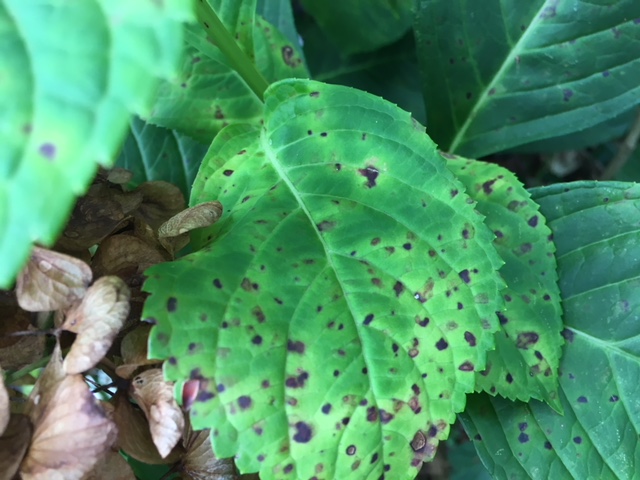
by Larry Williams | Aug 20, 2018
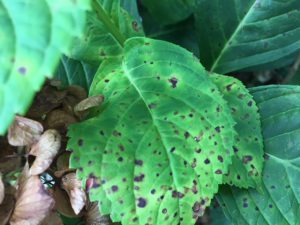
Hydrangea leaf spot disease
Photo credit: Larry Williams
It is not uncommon to see leaf spots on your hydrangeas during late summer and fall.
These spots are caused by a number of fungal diseases. Plant fungi and wet weather go hand-in-hand. Florida’s high humidity, heavy dews and frequent rains during spring and summer provide perfect conditions to allow fungal diseases to flourish. Bacterial leaf spots can be part of this foliage disease mix, too.
Common foliage diseases seen on hydrangeas this time of year include Phyllosticta leaf spot, Target leaf spot, Bacterial leaf spot, Botrytis and Cercospora leaf spot.
These foliage diseases are the norm rather than the exception as we move into the wet summer months and on into fall. As a matter of fact, you would be hard-pressed to find any hydrangea in our area without some evidence of infection now.
This late in the year it is more of a “grin and bear it” problem. In other words, it’s too late to do much about the fact that your hydrangea plant has leaves covered in ugly spots. By now many of the infected leaves are turning brown, withering and dropping prematurely from the plant.
Cercospora leaf spot is one of the most common foliage diseases of hydrangeas. Along with most of the leaf spot diseases, it begins as small dark-colored specks on the leaves. The small specks generally go unnoticed. But as the spots continue to slowly enlarge, mostly maintaining a circular shape, they become more obvious. With heavy infection, individual spots can coalesce forming larger irregular shaped brown areas on individual leaves. The individual spots may have a purplish halo with gray center.
There are some fungicides that can help prevent these leaf spots. But you’d have to begin treatment early in spring before any leaf spots exist and spray the plant every 10 to 14 days during favorable disease development (humid, rainy weather), which is pretty much our spring and summer months. These types of diseases are prevented, not cured. That’s the “grin and bear it” part of waiting until now.
The fungus survives on infected leaves. So, the best thing to do now is to remove and dispose of infected leaves. Also, be careful to not wet the leaves when irrigating the plants during the growing season.
New leaves of spring should be spot/disease free as they emerge. But the cycle of life for these leaf spot diseases will again result in spotted/diseased leaves on your hydrangeas next summer and fall without persistent treatment.
The good news is that these leaf spot diseases normally do not cause permanent/long-term damage for hydrangeas. They just make the plant look ugly.
by Matt Lollar | Jun 21, 2018
Are you interested in growing squash in your garden? Do you know the difference between summer squash and winter squash? Check out this very informative instructional video on growing squash in your home garden by Walton County Agriculture Agent Evan Anderson.
[youtube https://www.youtube.com/watch?v=hlbJfV-0FuU&w=560&h=315]
by Matt Lollar | Jun 4, 2018
Normally we think of rust as something that deteriorates metal, but a number of different fungal rusts can affect plants in the garden. Rust disease can affect corn plants, cedar trees, and even blueberry bushes. Just like the broad range of plant species that can be plagued by rust, there are a number of species of rust fungal spores floating around and ready to infest your garden. This article will focus on leaf rust of blueberry.
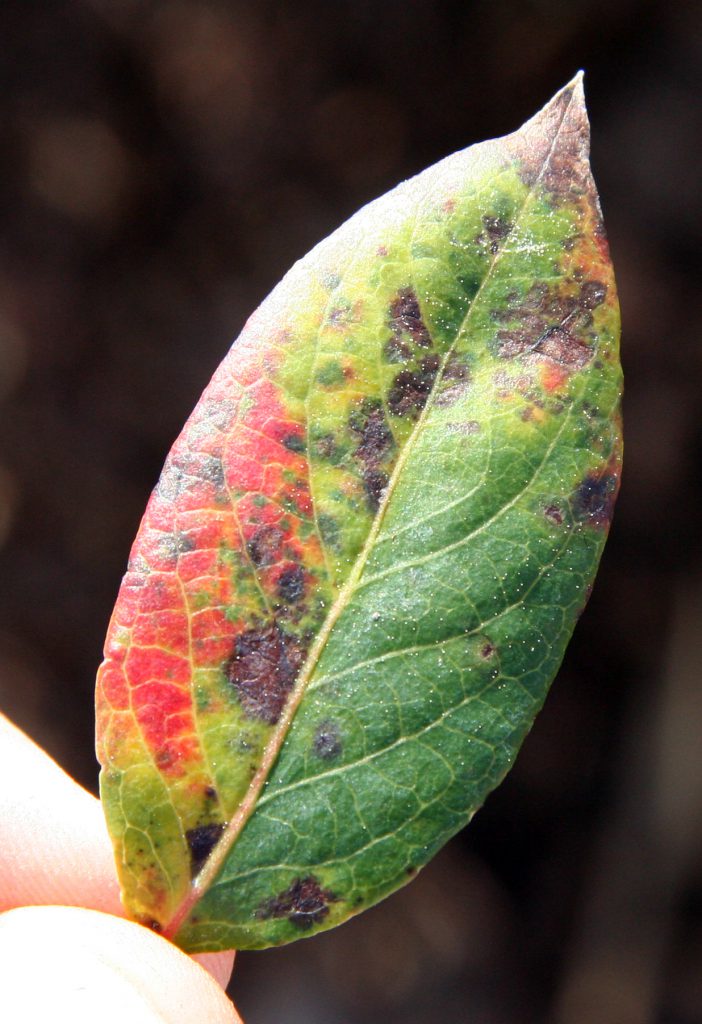
Blueberry leaf rust on the top of a leaf. Photo Credit: Philip Harmon, University of Florida/IFAS Extension.
Leaf rust of blueberry in Florida is caused by the fungus Pucciniastrum vaccinii. Although the common name of the disease is “leaf rust”, the disease can also infect the stems and fruit of blueberry plants. The disease causes small, round spots visible on the tops of leaves. Spots will multiply and the leaves will eventually yellow and fall off. Young stems and green fruit can also become infected as the disease progresses. Bright orange lesions will form on stems and fruit as the thousands of microscopic spores conjoin. The clusters of spores are easily wiped or washed off of plant material. When spores dry out, they become airborne and can be transferred to nearby plants.
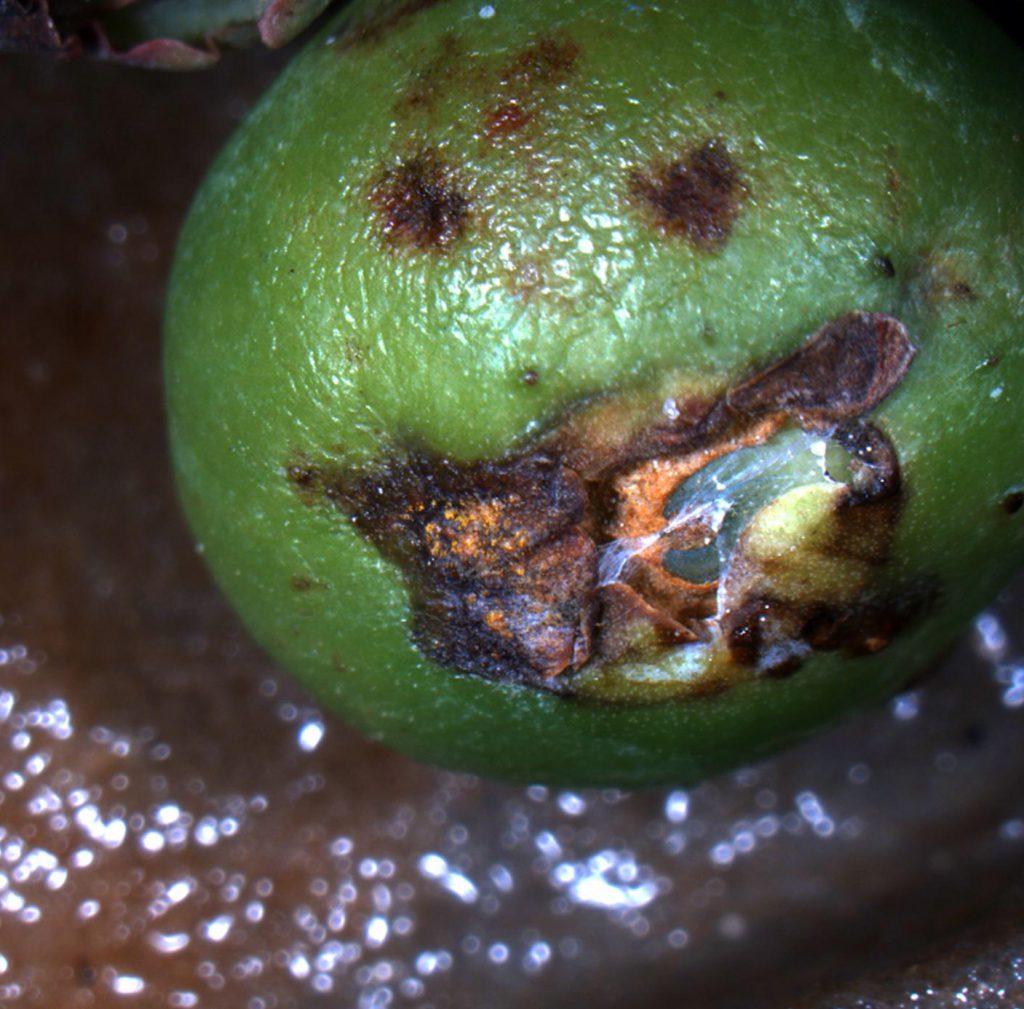
Blueberry leaf rust on fruit. Photo Credit: Philip Harmon, University of Florida/IFAS Extension
The rust fungus thrives in hot, humid, wet conditions. A number of cultural practices can be adopted to reduce disease progression and survival.
-
Irrigation
Disease persistence can be reduced by limiting the amount of water that contacts the plant leaves. Water the base of plants or install drip irrigation for your bushes rather than watering from overhead. If overhead irrigation is the only option, then water plants in the morning rather than in the evening. This allows the leaves to dry out over the course of the day.
-
Pruning
Removal of approximately 25% of the oldest canes in late winter before spring growth begins will stimulate the production of new canes and should result in plants with canes of different ages and will provide a good mix of vigorous branching and fruit production. Moderate summer pruning can also improve yield and shoot growth. When pruning, cut out vigorous shoots that are growing well beyond the desired canopy height and are in the interior portion of the bush. This will promote a more open growth habit and help with air circulation on the remaining plant material. Some vigorous canes developing from the ground and growing on the outside of the bush can be topped to stimulate branching and flower bud formation.
-
Mulch
Pine bark mulch helps with establishment of young plants and helps keep soil pH low in existing plantings. A layer of aged pine bark 3 inches deep extending about 2 feet out from the plants will provide a good growing medium for surface feeder roots. Pine straw can be used if pine bark is unavailable. Mulch also moderates soil temperature, helps keep weeds at bay, and adds organic matter to the soil. Make sure to keep mulch raked back about three inches away from the plant canes to provide good air circulation to the roots.
Hopefully this article has given you some tips to have a good blueberry crop for years to come. For more information on growing blueberries in Florida, please visit the University of Florida/IFAS EDIS Publication: Blueberry Gardener’s Guide.
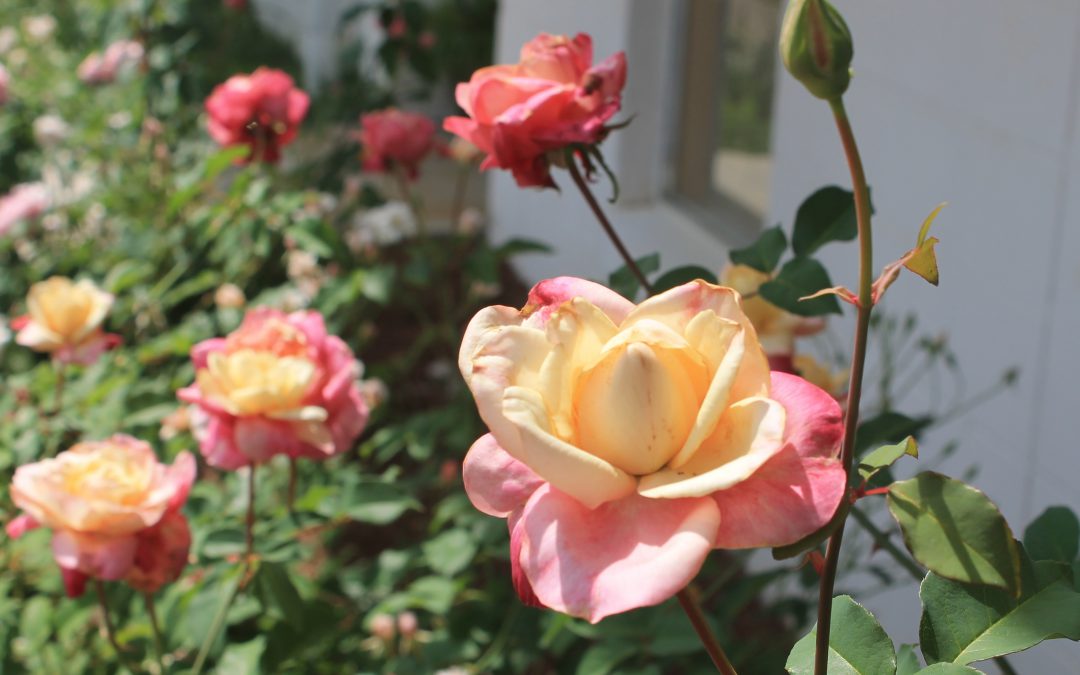
by Matthew Orwat | Apr 17, 2018
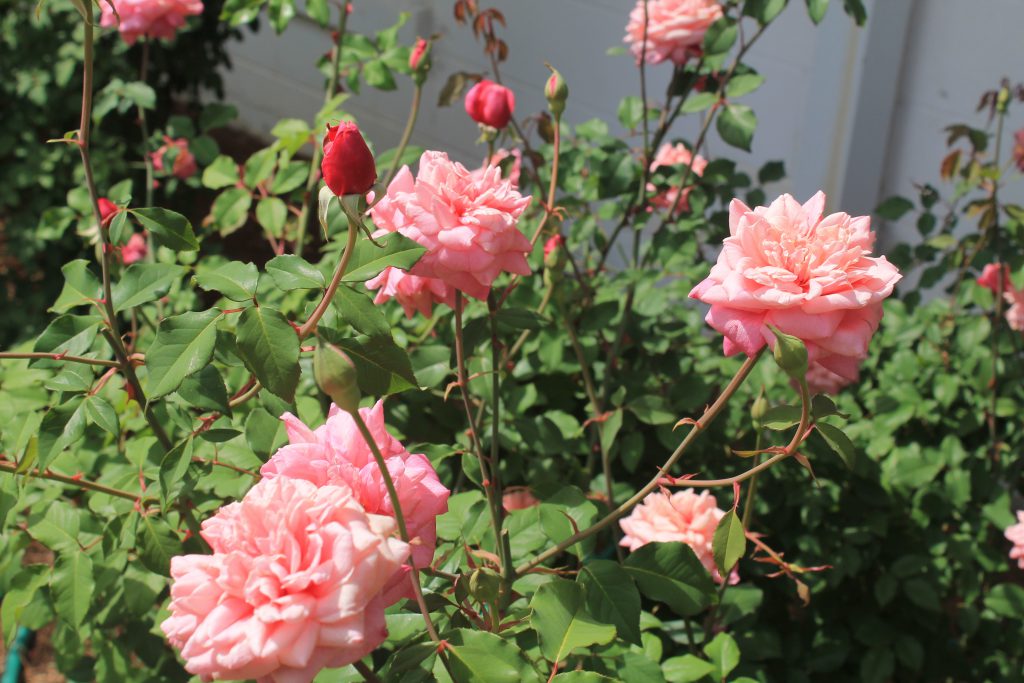
Monsieur Tillier – Tea rose from the late 1800s. A good choice where a large, free-flowering shrub is needed – Image Credit Matthew Orwat
Home Gardeners, when they think of roses, their mind inevitably turns to the ‘Knockout’ rose and its offspring. That’s fine, there’s nothing wrong with ‘Knockout’ roses, it makes a great ornamental landscape plant, and it’s easy to propagate.
With all the ‘Knockout’ mania, since the early 2000s, many garden roses, that are well adapted to the Northwest Florida climate, have been left out of the home garden to a large degree.
Several roses, which were grown in Florida commonly in the last hundred years, and recommended by former University of Florida president H. H. Hume in his book “Gardening in the Lower South,” are still grown here today. To obtain these roses gardeners must look to small nurseries scattered throughout central Florida and Alabama, or order them from larger nurseries in Texas where the “Texas A&M Earthkind Rose Program” has taken off.
Below are a few examples of easy to grow roses, that are just as disease resistant as the ‘Knockout,’ but offer more variety in color and form that home gardeners might enjoy as much as or more than ‘Knockout’. They have been grown successfully throughout southern Texas for over 30 years, and at the Washington County Extension Office for the past seven years without spraying fungicides or insecticides. Several of these cultivars were also involved in a 3-year rose trial at the UF/IFAS North Florida Research and Education Center, in Quincy.
One caveat I have regarding these roses is that disease resistance is lessened when irrigated with overhead irrigation. Even the most disease resistant roses will develop issues if leaves are constantly left wet.
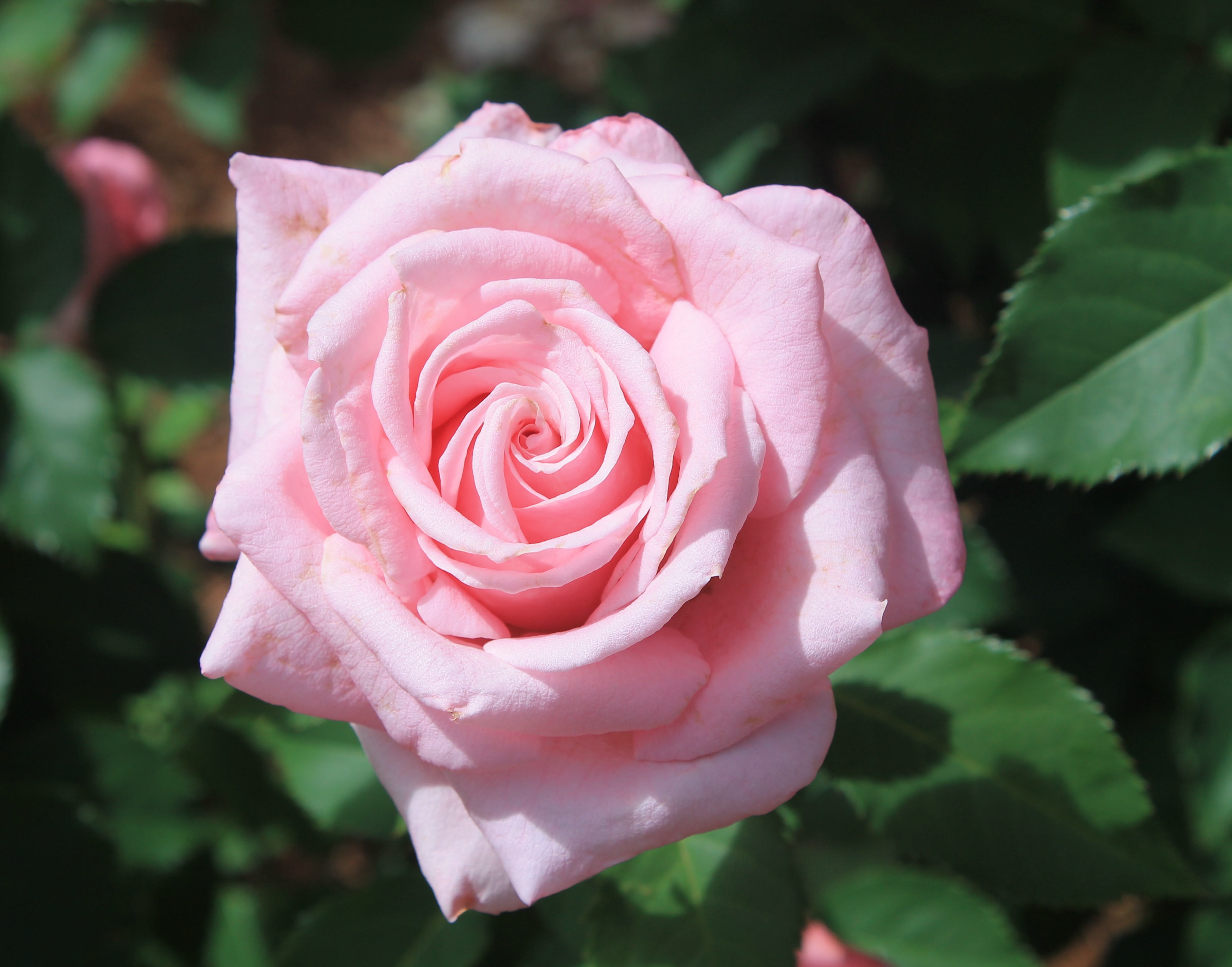
Belinda’s Dream makes a moderately sized shrub and produces large flowers, especially in the spring and fall. Image Credit – Matthew Orwat
‘Belinda’s Dream’
‘Belinda’s Dream‘ was bred by Texas A&M Professor Robert Basye in 1988, as a culmination of years of intense breeding and selection for disease resistant landscape and cut flower roses. It makes a 4-5 foot shrub that grows about 3 feet wide. Apple-green foliage clothe its pleasing shrub form. It’s free flowering but not overly vigorous, so it’s easy to keep in bounds. Disease resistance is high, there’s rarely any blackspot of note, under no-spray conditions, and only slight powdery mildew in a few years when conditions are favorable for fungus development.
In cool spring or fall conditions, the clear pink flowers can top six inches in diameter, and contain over 200 petals, but regular hot conditions during the summer usually reduce flower size to four inches. This rose loves to be part of mass plantings, particularly when planted 3 feet apart in a triangular formation. It has a reputation as being moderately easy to propagate.

Rosette Delizy is very colorful and disease resistant. A great addition where a spot of color is needed – Image Credit Matthew Orwat
‘Rosette Delizy’
‘Rosette Delizy‘ is a French Tea rose that was introduced to the U.S. nursery trade in the mid-1920s. Since it was bred before the days of modern fungicides, it sports excellent resistance to disease. It shows no powdery mildew, and only the occasional leaf with blackspot under no-spray conditions.
This is strictly a rose for the coastal south, since it does not like cold temperatures, and cannot thrive north of zone 7b without protection.
Color is striking, opening yellow with petal edges changing to pink as the flowers age. Cooler weather brings out deeper russet and maroon tones. It has a light “tea” fragrance. This mannerly shrub gets 4-5 feet tall and 3-4 feet wide. It requires very light pruning, and can actually be killed from heavy-handed gardeners with shears in hand. Minor flaws noted in this rose are that it is somewhat sparsely foliated, and somewhat difficult to propagate.

Madame Antoine Mari – The perfect buttonhole rose produces flowers with delicate, soft colors perfect for arranging. This rose is a mannerly grower suitable for smaller landscapes. Image Credit Matthew Orwat
‘Madame Antoine Mari’
‘Madame Antione Mari’, a Tea rose, was introduced in 1900 when the buttonhole rose was all the rage. Massive quantities of perfectly formed delicate buds of pink and ivory quickly open into 3 inch flowers that decorate the bush like butterflies fluttering in the wind. Re-bloom is fast. Additional interest in the landscape is created by the deep red color of new foliage.
This makes a mannerly shrub for the small landscape, easily kept at 3-4 feet tall, and 5-6 feet wide by light pruning. Disease resistance is above average in a no-spray garden, with very low blackspot infection rates, and only occasional powdery mildew. This rose has been found to be easily propagated with the author reaching near 100% success rate.

Mrs. B. R. Cant at the Quincy rose trial in 2013.
‘Mrs. B. R. Cant’
No mention of easy to grow roses is complete without the mention of ‘Mrs. B. R. Cant’. In the trials UF/IFAS horticulturists performed at Quincy and Plant City, this variety was rated the best performer. It has been in continuous cultivation since 1901, and is often found at old home sites and gardens in Washington County.
This makes a large garden rose, easily topping 8 feet in height, and just as wide. Deep pink flowers are borne profusely from March to first frost. Disease resistance is outstanding, and it’s easy to propagate. Plants are densely clothed in medium green leaves. This rose is often grown in hedges as a substitute for a fence. One of the best all-around garden roses for the gulf south.
Nursery Availability
I provide presentations at workshops on these roses multiple times a year, throughout the Florida Panhandle. The recurring question I get is, “Where are these roses available locally?” Hopefully this article will inspire some local gardeners to try these easy to grow roses, and others, since these are just a few of the roses available that do very well in North Florida under no spray conditions. If you are interested in more information, contact, Matthew Orwat at UF/IFAS Extension Washington County.
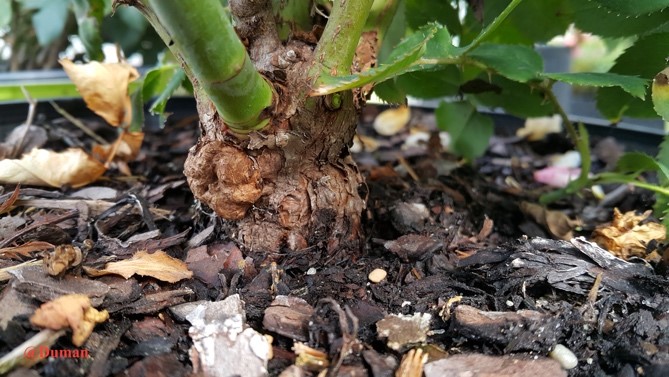
by Gary Knox | Nov 6, 2017

Crown gall symptoms on roses caused by the bacterium Agrobacterium tumefaciens (Rhizobium radiobacter) – Photo credits: Kamil Duman
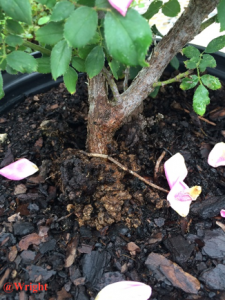
A plant with a mature gall that is potentially releasing the crown gall bacterium into the potting media. Photo credits: Susannah Wright
For gardeners, rose enthusiasts and rosarians, each of the many rose diseases is as important as the others. But we can say for sure Crown Gall is one of the most unsightly of the many rose diseases that can been seen currently.
The disease got this name from the large tumor-like swellings (galls) that typically occur at the crown of the plant, just above the soil level. The cause of crown gall disease is a bacterium that resides in the soil, Agrobacterium tumefaciens (updated scientific name Rhizobium radiobacter).
SYMPTOMS
Galls or overgrowth (1/4 inch to several inches in diameter) of host plant tissue typically form at the soil line but also can form on branches or roots. Galls are initially white, spherical, and soft but darken with age as outer cells die. It can either be almost entirely on the surface of the plant and easily detached or can be almost indistinguishable from normal plant tissue except for its greatly enlarged appearance.
The bacterium that causes Crown Gall disease survives and persists in the soil for up to 3 years. It can invade recent wounds on the branches or roots. Swelling can be seen as early as 14 days following entry of the bacterium into the plant. The tissue near the gall can be crushed due to rapid cell enlargement. If vascular tissue is crushed, wilting can result from the restricted water movement.
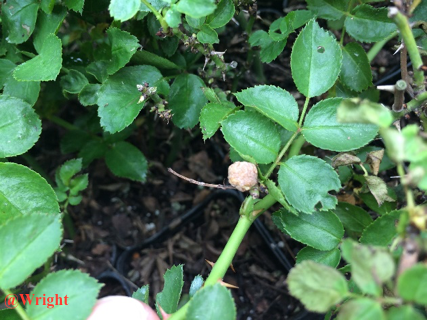
Early stage symptom of Crown Gall on roses can be noticed as the small white galls. Photo credits: Susannah Wright
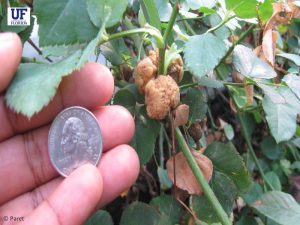
The galls can enlarge to a quarter size in a short period of time from the initial small galls. Photo credits: Mathews Paret
ABOUT THE BACTERIUM
Agrobacterium uses its genes as a weapon to attack plants. It enters the plant mostly from the soil through wounds on the roots or lower stem or from the branches during plant pruning. Symptoms are caused by the insertion of a small segment of DNA (known as the T-DNA), from a plasmid, into the host plant cell, which is incorporated into the plant genome. When the plasmid links up with the plants own DNA, the altered plant cells start dividing rapidly and uncontrollably, and the root or stem develops a tumor-like swelling.
Galls can range from pea size to softball size. Tiny cracks from freezing temperatures or wound sites can be the site of gall formation. Once the wound compounds are generated, the bacteria detach from the xylem cell walls and are carried upward with water during evapotranspiration to the wound site where they initiate galls. One of the common ways of the spread of the disease is by pruning infected plants and moving the bacterium accidentally while pruning nearby healthy plants.
The crown gall bacterium is a soil pathogen, which means main inoculum source is soil. The bacterium can overwinter in infested soils, where it can live as a saprophyte for several years. The bacterium can easily during field preparation, pruning and irrigation. Insects, nematodes and grafting materials, can also transfer the bacterium.
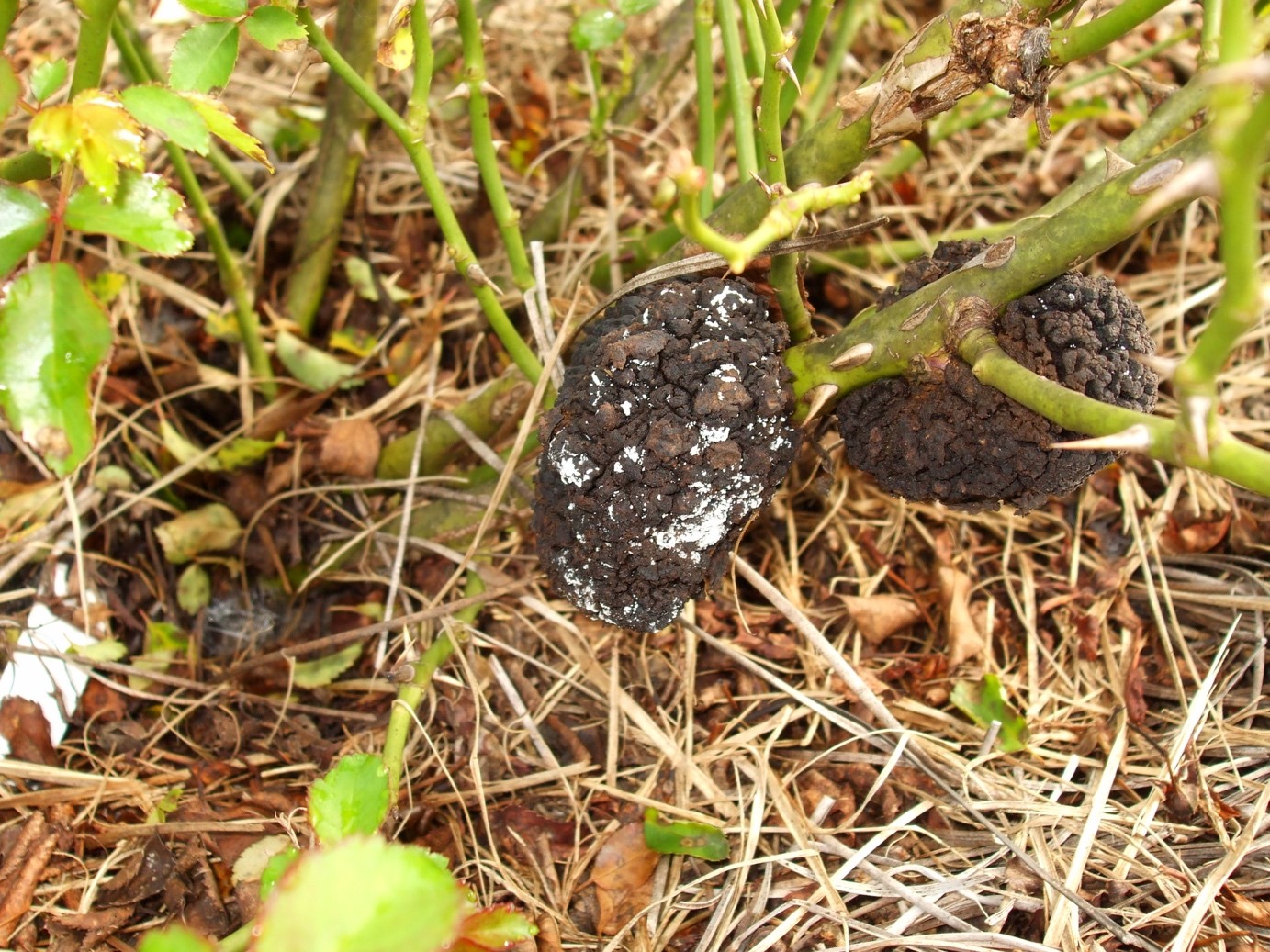
The galls will turn dark in color as they age. Photo credits: Kamil Duman
HOW CAN YOU MANAGE ROSE CROWN GALL DISEASE
- Plant only disease-free roses. Check very carefully before you buy plants for any kind of galls in the crown or branches. Use good sanitation practices in handling roses.
- Plant in clean soil. Avoid areas with a history of crown gall infestation.
- Avoid fields with heavy infestations of root-attacking insects and nematodes.
- Select well-drained soil and irrigate from clean water sources.
- Keep grafts and buds well above the soil line.
- Destroy diseased plants as soon as you notice them to avoid cross-contaminating other plants, or pruning equipment. Also, do not keep infected plants with healthy plants, as the likelihood of accidental transmission through pruning is high.
- Avoid mechanical injury to plants from tillage and hoeing. Provide winter protection so that the bark does not crack.
- Disinfect pruning tools between plants. disinfect budding/grafting tools before and after use. Bleach (10%; equivalent to 0.6% sodium hypochlorite), or quaternary ammonium-based sanitizer are effective as disinfectants. Make sure to prepare fresh stock routinely.
- If crown gall plants are noted, please let your local county extension agent know about it and they will be able to contact us for additional site-specific management plans if needed.
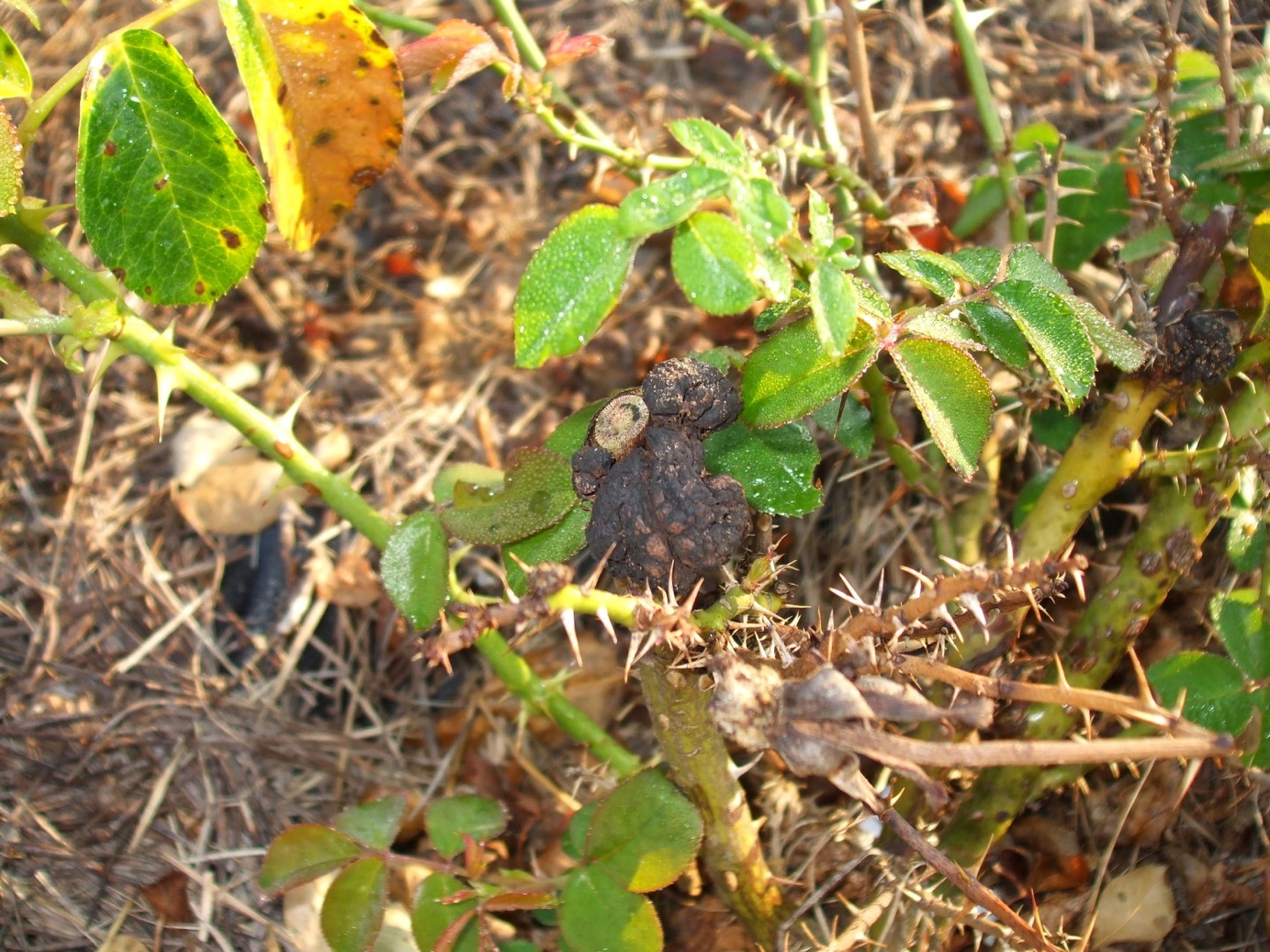
Gall formation at pruning sites indicating contamination of the plant during pruning. Photo credits: Kamil Duman
Authors: Kamil Duman, Susannah Wright, Fanny Iriarte, Barron Riddle, Gary Knox and Mathews Paret, University of Florida – NFREC, Quincy, FL
















